Yamaha SuperJet
The SuperJet is a stand-up type personal watercraft (PWC) made by Yamaha Motor Corporation. Part of Yamaha's WaveRunner line of watercraft, it was introduced in 1990 and has become one of the most successful stand-up personal watercraft ever made.[1] All SuperJets, including the engine, are hand-built in Japan. Credit for the design is given to Clayton Jacobson II.
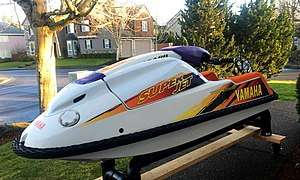 A 1996 Yamaha SuperJet, the first year of the 701cc straight twin two-stroke engine with twin Mikuni carburetors | |
| Manufacturer | Yamaha Motor Corporation |
|---|---|
| Also called | SuperJet, 701, Square nose (SN), Round nose (RN) |
| Production | 1990 - present (2020) |
| Assembly |
|
| Class | Personal watercraft |
| Engine |
|
| Bore / stroke | 81 mm × 68 mm (3.19 in × 2.68 in) (SJ700AU) |
| Power | 73 hp (54 kW) @6,300 rpm (SJ700AU) |
| Dimensions | L: 88.2 in (2,240 mm) (SJ700AU) W: 26.8 in (681 mm) H: 26.0 in (660 mm) |
| Weight | 291 lb (132 kg) (SJ700AU) (dry) |
| Fuel capacity | 4.8 U.S. gallons (18 L), including 1.45 U.S. gallons (5.5 L) reserve. (SJ700AU) |
| Oil capacity |
|
| Fuel consumption | 7.7 US gal/h (29 L/h) max (SJ700AU) |
Prior to the introduction of the new Kawasaki SX-R 1500 four stroke on October 6, 2016, it has been the only stand-up sold by a major manufacturer since the Kawasaki SX-R 800 was discontinued in 2011.
There are three engine generations spanning 1990-1993, 1994-1995, and 1996-2020, and three hull generations spanning 1990-1995, 1996-2007, and 2008-2020. 2019 marks the 30th year of production for the SuperJet.
The current model SuperJet is powered by a 701cc inline two-cylinder, two-stroke engine.
All generations have an upper and lower hull constructed from SMC (sheet molded compound). SMC is a compression moldable composite material made of long strands of glass fibers suspended in a polyester resin.
The Yamaha FX-1 is the only other stand-up personal watercraft produced by Yamaha, and was produced in limited numbers from 1994-1995.
On August 12, 2020 Yamaha released the new 2021 SuperJet. This is the first complete redesign from the ground up since the introduction in 1990, and marks 30 years of SuperJet history. The hull is entirely new and it is now powered by Yamaha's 1,049cc three-cylinder four-stroke TR-1 marine engine.
Model Designations
Yamaha numbers its models according to their make (in the case of the SuperJet, all models begin with the letters SJ) followed by the engine size (given in approximate cubic centimeters— the 650cc referred to as 650 and the 701cc referred to as 700) and the year in which the vehicle was made, given as either a one or two letter designation and increasing by one ‘letter' each full year, with an optional letter placed before the year letter as an amendment code.
For example, the letter year designation for the year 1994 for the SuperJet was the letter S, so a SuperJet manufactured in 1994 would have the designation SJ700S. However, Yamaha made engine and chassis changes to the SJ700 for 1996, so appropriately an amendment code was added and a 1996 model has the designation SJ700AU, and in 2002 they increased the amendment by one to ‘roll over’ the letter years so the designation is SJ700BA. The model year 2018 has the designation SJ700BT. There was not a specific amendment code associated with the 2008 hull refresh.
SuperJet 1990-1993 (SJ650D,P,Q,R)[Generation 1]
The 1990 SuperJet was the first year of Yamaha's stand-up PWC offering.
Motor
- Common name: 650 Square Nose (SN)
- Displacement: 633cc, Inline 2-Cylinder, 2-Stroke (6M6 cylinder, 6M6 cases)
- Rated Power Output: 50 hp (37 kW)
- Fuel type: Regular 86 PON (90 RON) unleaded gasoline
- Premix ratio, gas/oil: 50:1
- Single Carb (Mikuni Super BN44) with twin stainless steel 6-petal reed valves
- RPM Limiter: 6500-6600 rpm
Chassis
- Length: 86.04 in (2,185 mm)
- Width: 28 in (710 mm)
- Height: 26 in (660 mm)
- Weight, dry: 287 lb (130 kg)
- Max speed: 38.2 mph (61.5 km/h)
SuperJet 1994-1995 (SJ700S-T)[Generation 1-Upgraded Engine)
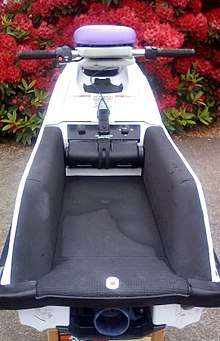
The 1995 SuperJet received an all-new 701cc two-cylinder engine. The body remains the same as the previous generation with a "Square nose" top deck and standard SuperJet bottom deck.
Motor
- Common name: 701 Square Nose (SN)
- Displacement: 701cc, Inline two-cylinder, two-stroke (61X cylinder, 61X cases)
- Rated Power Output: 63 hp (47 kW)
- Fuel type: Regular 86 PON (90 RON) unleaded gasoline
- Type of Lubrication: Pre-mixed fuel and oil
- Premix ratio, gas/oil: 50:1, Yamalube 2-W or TC-W3 equivalent
- Single Carb (Mikuni Super BN44) with twin stainless steel 6-petal reed valves
- RPM Limiter: 7050-7150 rpm
Chassis
- Length: 86.04 in (2,185 mm)
- Width: 28 in (710 mm)
- Height: 26 in (660 mm)
- Weight, dry: 291 lb (132 kg)
- Max speed: 42 mph (68 km/h)
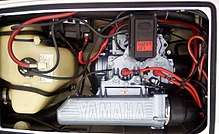
SuperJet 1996-2007 (SJ700AU-BF)[Generation 2]
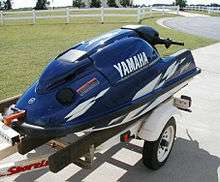
The body consists of a new "Round nose" top deck (or hull) and the same standard SuperJet bottom deck as the previous "Square nose" model.
Motor
- Common name: 701 or Round Nose (RN)
- Displacement: 701cc, Inline 2-Cylinder, 2-Stroke (61X cylinder, 62T cases)
- Bore x stroke: 81.0 mm × 68 mm (3.19 in × 2.68 in)
- Compression ratio: 7.2:1
- Rated Power Output: 73 hp (54 kW) @6,300 rpm
- Dual carb (Mikuni Super BN38) with reed valves
- Fuel type: Regular 86 PON (90 RON) unleaded gasoline
- Type of Lubrication: Pre-mixed fuel and oil
- Premix ratio, gas/oil: 50:1, Yamalube 2-W or TC-W3 equivalent
- Max fuel consumption: 7.7 US gal/h (29 L/h)
- Range at full throttle: 0.6 hrs
- Spark plug: B8HS / BR8HS (NGK 6715)
- Ignition Timing: 15° BTDC - 21° BTDC, variable over the RPM range
- RPM Limiter: 7050-7150 rpm
Chassis
- Fuel capacity: 4.8 U.S. gallons (18 L; 4.0 imp gal) total, with 1.5 U.S. gallons (5.7 L; 1.2 imp gal) reserve
- Length (in): 88.2 in (2,240 mm)
- Width (in): 26.8 in (680 mm)
- Height (in): 26.0 in (660 mm)
- Weight, dry: 291 lb (132 kg)
- Max speed: 45.4 mph (73.1 km/h)
SuperJet 2008-2020 (SJ700BG-BV)[Generation 2-Upgraded Hull]
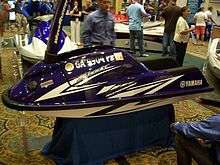
The current SuperJet (produced by Yamaha Motor and hand-built in Japan) has been visually the same since 1996. The 2008 model was the first year of a new bottom deck, changed for the first time in the history of the SuperJet.
This watercraft no longer meets California or New York two-stroke emissions standards as a new vessel (however, previously titled vessels can still be registered in CA).
Purchasing a SuperJet new from a dealer will usually require a license from IJSBA as they are classified as a "competition use only" watercraft, partly due to stringent EPA regulations for two-stroke engines. An annual membership from IJSBA is $65 for the first year as of May 2018, with renewal at $60 per year, if desired. These memberships can be purchased from the dealer in most cases.
Body Updates
The new 2008 has the same Roundnose top deck that was introduced in 1996, with a new bottom deck (or hull) incorporating the first changes since 1990 when the SuperJet was released.
The new bottom hull has incorporated side sponsons (similar to adding "Blowsion tubbies") onto the hull. The rear of the hull is also slightly narrower and has deeper strakes for improved tracking.
The handle pole on the 2008 SuperJet is 50 mm shorter than previous generation Roundnose SuperJets, which moves the rider forward slightly in the tray.
Mechanical Updates
The intake grate, pump, and ride plate are all set back 50 mm rearward compared to the past year SuperJets.
The engine remains as the same reliable two-cylinder twin carb as the previous 1996+ years, with no noted mechanical changes.
The impeller was updated to a newly designed geometry and made from stainless steel for the first time, in comparison to the previous aluminum design that remained the same throughout 1990-2007. The new impeller design offers large improvements in hookup as well as reduced pump cavitation. The prop driveshaft was changed to a constant diameter over the entire length to increase stiffness, versus previous years in which it is necked down to a smaller diameter in the center section. However, the impeller is backwards compatible with all older models and can be installed on any year SuperJet to replace the original aluminum impeller design.
Model Year Cosmetic Updates
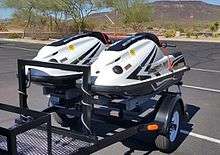
- 2008 - 2009 SuperJets are blue with white graphics.
- 2010 - 2011 SuperJets are blue with redesigned white graphics.
- 2012 - 2013 SuperJets are a new black color with orange graphics.
- In 2014, the SuperJet is back in black again, this time with blue graphics.
- 2015 SuperJets retain the same black and blue graphics from the previous year.
- For 2016, the SuperJet SJ700BR is available in two new color options: Pure White with Orange & Blue or Pure White with Black. This is the first time the main body color has been white since 1997.
- For 2017, the SuperJet SJ700BS is available in the same 2016 colors: Pure White with Orange & Blue or Pure White with Black.
- For 2018, the SuperJet SJ700BT is available in an all new color: Pure White with Blue & Green stripes.
- For 2019, the SuperJet SJ700BU is available in the same 2018 color: Pure White with Blue & Green stripes.
- For 2020, the SuperJet SJ700BV is available in the same 2018-2019 colors: Pure White with Blue & Green stripes. However, the name was changed to White with Blue. The MSRP also increased for the first time since 2014.[2]
Full Specifications
- Rated Power Output: 73 hp (54 kW) @6,300 rpm
- Engine Type: Inline 2-Cylinder, 2-Stroke (61X cylinder, 62T cases)
- Displacement: 701 cc
- Bore x Stroke: 81.0 mm × 68.0 mm (3.19 in × 2.68 in)
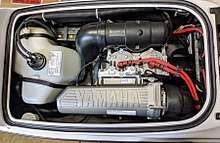
- Compression Ratio: 7.2:1
- Carburetion: Twin Mikuni Super BN 38
- Fuel type: Regular 86 PON (90 RON) unleaded gasoline
- Type of Lubrication: Pre-mixed fuel and oil
- Oil mixing Ratio: 50:1, Yamalube 2-W or TC-W3 equivalent
- Type of Intake: Twin reed valve, stainless steel 8 pedal
- Type of Scavenging: Loop-Charged
- Type of Exhaust: Wet
- Cooling system: Open loop fresh water
- Starting system: Electric
- Ignition: CDI
- Battery capacity: 12 V, 19.0 Ah, Yuasa YB16CL-B
- Spark plug: B7HS/BR7HS (NGK 5110), 0.024–0.028 in (0.61–0.71 mm) gap
- Spark Advance: 6°
- Ignition Timing: 15° BTDC - 21° BTDC, variable over the RPM range
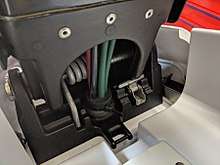
- Trolling speed: 1300 ±50 rpm
- RPM Limiter: 7050-7150 rpm
- Propulsion system: Jet pump
- Jet Pump type: 144 mm axial flow, single stage
- Transmission: Direct shaft drive from engine
- Impeller: 3-Blade stainless steel (13/16 pitch), counterclockwise rotation
- Length: 88.2 in (2,240 mm)
- Width: 26.8 in (681 mm)
- Height: 26.0 in (660 mm)
- Dry Weight: 306 lb (139 kg)
- Total Fuel Capacity: 4.8 U.S. gallons (18 L; 4.0 imp gal)
- Reserve Fuel Capacity: 1.45 U.S. gallons (5.5 L; 1.21 imp gal)
- Maximum Fuel Consumption: 7.7 US gal/h (29 L/h)
- Cruising range at full throttle: 0.62 hour
- Vehicle Capacity: 1 person
- Hull Material: SMC (Sheet Moulded Compound)
- Sold without warranty and for competition use only
- 2016 MSRP: $8,499.00 in the USA, £6,699.00 in the UK, and ¥ 1,009,060 in Japan
- 2017 MSRP: $8,499.00 in the USA
- 2018 MSRP: $8,499.00 in the USA
- 2019 MSRP: $8,499.00 in the USA
- 2020 MSRP: $8,699.00 in the USA
SuperJet 2021 [Generation 3]
The 2021 SuperJet has been completely redesigned from the ground up. Yamaha says "This year marks the return of the Yamaha SuperJet, all-new from the ground up to challenge a new generation of stand-up riders with a torquey four-stroke Yamaha marine engine and nimble performance hull that is 142 pounds lighter and 8.8 inches shorter than its competition."
The largest change is moving from a two-stroke twin-cylinder engine to Yamaha dropping in their three-cylinder four-stroke 1049cc TR-1 marine engine. The hull has also been completely redesigned from the ground up with a new 144mm pump, adjustable steering nozzle, and reboarding grab handle in the tray.
The TR-1 marine engine weighs 160lbs and is 30"L by 21"W by 19"H inches in size, producing 100hp. It has an integrated oil tank, ECU and air filter onto the engine.
The launch price is $9,499 USD and the ski is still Made in Japan (as all past Super Jets have been).
Full specs to be updated as they are available.
| Manufacturer | Yamaha Motor Corporation |
|---|---|
| Also called | SuperJet |
| Production | 2021 |
| Assembly |
|
| Class | Personal watercraft |
| Engine | TR-1 3-cylinder 4-stroke 1049cc |
| Bore / stroke | 82 mm × 66 mm (3.23 in × 2.60 in) |
| Power | 100hp |
| Dimensions | L: 95.7 in (2,431 mm) W: 30 in (762 mm) H: 31.1 in (790 mm) |
| Weight | 375 lb (170 kg) (dry) |
| Fuel capacity | 5 U.S. gallons (19 L), including 1.45 U.S. gallons (5.5 L) reserve. (SJ700AU) |
| Oil capacity | 3.91 quarts |
MSRP History By Year

See also
External links
- U.S. Coast Guard Boating Safety
- Personal Watercraft Industry Association
- American Watercraft Association
- X-h2o is a stand-up PWC focused forum, both recreational and professional.
- PWCToday forum discusses all types of PWC's
- Green Hulk Performance is a forum for all types of PWC's, largely focused on the sit-down type
- Yamaha Motors EU SuperJet product page
References
- "If It Ain't Broke: 2016 Yamaha SuperJet WaveRunner". Watercraft Journal. Archived from the original on 11 July 2018.
- "GALLERY: INTRODUCING THE 2020 YAMAHA WAVERUNNER LINEUP". Watercraft Journal. Retrieved 16 August 2019.